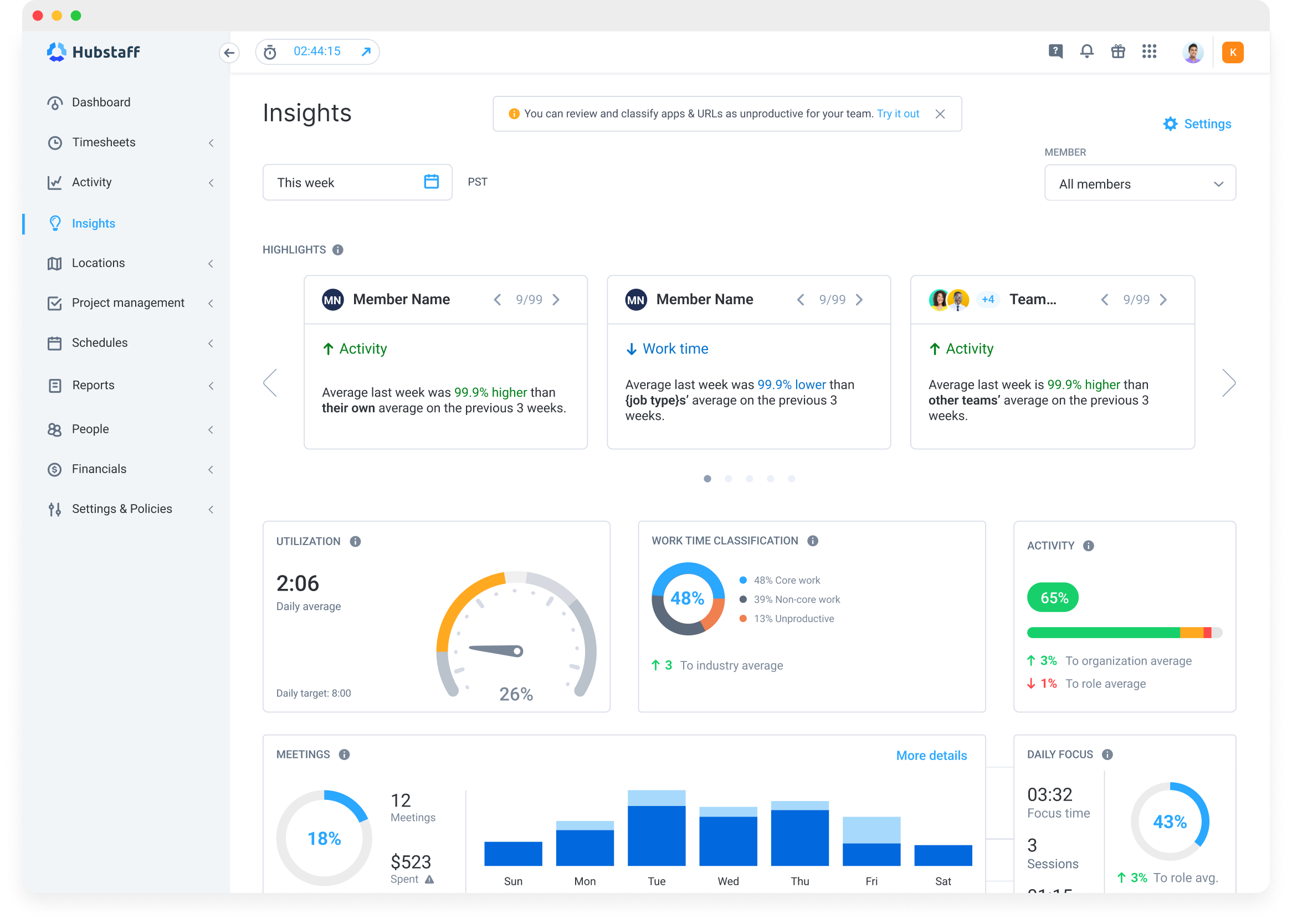If you had an hour of free time, how would you spend it? If this question is hard to answer, author Brigid Shulte might be onto something with her time confetti concept.
Ideally, you’d sit down and relax while looking out the window. Maybe read a book or listen to some music with a coffee. But what would you actually end up doing?
For many, this time becomes an opportunity to do more work (albeit in smaller chunks) to “be more productive.”
This phenomenon is called time confetti, to which many have fallen victim. In this guide, we’ll discuss what it is, how it affects the way you use time, and how to avoid it.
Boost your team’s efficiency with Hubstaff's productivity tools
What is time confetti?
Time confetti is a concept that originated with Brigid Schulte, author of Overwhelmed: How to Work, Love & Play When No One Has the Time. It’s the term she’s coined for the human behavior of using free time to do little bits of seemingly inconsequential tasks.
Time confetti encapsulates the modern human obsession with the idea of productivity every second of the day, to the point where they neglect more important things like family and personal interests.
Time management and time confetti
Despite the core idea behind time confetti being getting work done whenever the opportunity presents itself, it hinders the long-term benefits of proper time management. After all, taking breaks is part of any good time management strategy.
The primary danger is that when you’ve become accustomed to working while you’re supposed to be resting, you become more vulnerable to burnout and fatigue.
From the book: “As work weeks get longer and leisure time shrinks, people are becoming sicker, more distracted, absent, unproductive, and less innovative.”
The impact of time confetti on daily life
Initially, it can seem as if time confetti adds to your productivity. However, this is far from the truth, and it becomes a major threat to work-life balance in the long term.
Yes, you can potentially push a task forward with a few minutes’ worth of replying to a Slack message. Perhaps 10 minutes out of your break time sounds inconsequential to you. Maybe you think you don’t need a full hour to prepare for the next half of the workday.
To put things into perspective, If you multiply those 10 minutes lost by the 250 working days per year, you’ll get 2500 minutes (or just under 42 hours). In other words, you’ll be working an unnecessary and unpaid week instead of getting precious rest.
The amount of time isn’t the most impactful aspect of time confetti, though — it’s the way it distorts your mindset toward breaks and non-work time in general.
On the surface, it may seem like you’re getting more done. However, that’s exactly how time confetti invades your time.
First, you feel satisfied with making progress at work, even during supposedly non-productive hours. Then, you actively look for more windows to work even when you don’t need to.
Finally, being interrupted constantly becomes normal to you. Every second you’re not working becomes frustrating and unfulfilling and deteriorates your quality of life.

Recognizing when time confetti is taking over your schedule
Time confetti forces you to develop a fragmented approach toward your time. It becomes really dangerous when this behavior bleeds into your daily routines, and you start feeling symptoms like:
- Inability to relax during break times
- Decreased ability to focus
- Anxiety when you’re not “busy”
- Stronger tendency towards unproductive multitasking
- Feeling like you never have enough time
Generally speaking, if you feel a strong need to feel busy at all times and dissatisfaction or anxiety when you’re not, that’s a strong indicator of time confetti.
Strategies for managing time confetti
Back in 1999, a 25-year-old researcher at the University of Michigan got her start conducting experiments on time famine. Over 25 years and one successful paper later, Leslie Perlow is now a professor a Harvard Business School who many credit for discovering time confetti.
Years later, it’s clear that Leslie had the solution to time confetti all along. The primary way to truly combat it is to block out time for uninterrupted work.
1. Practice time blocking
Going into a workday with a vague goal like “I’m going to do ten tasks today” isn’t a good idea.
Measuring the success of a workday by the number of things you accomplish is unreasonable and unproductive. Productivity should be measured by your contributions to your team and their impact on company goals — not by the quantity of work you managed to squeeze into a single day.
Enter time blocking, a productivity technique that requires you to be intentional about your limited time at work. Assign blocks of your time for specific tasks and do your best not to deviate from them.
Make sure to also set aside time for the small things you typically do in between tasks (i.e., your “time confetti” tasks). This helps prevent unnecessary context switching while still allotting time for these less important to-dos.
2. Take genuine breaks during break times
It isn’t uncommon for employees to put in some work during lunch breaks or, worse, skip breaks altogether. In a 2022 survey by Tork, 39% of the respondents said they “occasionally, rarely or never take breaks” at work.
Ironically, not working during breaks helps you save time at work because it helps rejuvenate your mind. The most crucial moment of a work break is the beginning. You might be in the middle of something and want to steal time from your break to finish it.
In many cases, this is where time confetti’s roots are planted. It’s only a few minutes at first, but you might see yourself working during the entire break over time.
The best way to handle this is to leave your desk as soon as break time starts. It might be difficult at first, but force yourself not to think about work while you’re on break. Use your free time in meaningful ways like:
- Enjoying a healthy snack or meal
- Immersing in a book
- Practicing breathing exercises to relieve stress
- Talking to a friend about anything that isn’t about work
If you find it difficult to ignore messages from colleagues when you notice them, consider turning off email and Slack notifications on your mobile device.
Eventually, this will help you stop thinking about work as much during your free time, improving the quality of your breaks and mental health when you return to work.
3. Learn to say no
When a teammate asks for your help with something, it’s generally a good thing (and a great feeling). Who wouldn’t want their colleague’s trust in their abilities?
It becomes alarming, however, when you say yes every single time — even when it means disrupting your workflow or consuming non-work time. If you’re a leader, you’ll also set a bad example as someone who doesn’t respect their own free time.
Learning to say no isn’t a pleasant skill to learn. However, it’s a necessary one if you want to truly gain autonomy and work-life balance.
If you need one hour to finish an important task, commit a full hour. If a teammate asks for help in the middle of the task:
- Help your teammate if you complete the task early, but don’t force yourself to finish early so you can squeeze them into your schedule.
- Help them if you find free time during work hours, but don’t consume free time outside of work hours.
That said, there will be times when the tasks they need help with are more important or urgent, but these should be exceptions and not the norm.
Tools and apps for time confetti management
1. Time trackers
One of the most alarming characteristics of time confetti is its ability to bleed seamlessly into your workflow. A time tracking tool like Hubstaff counteracts this.
With Hubstaff, you can:
- Create tasks and accurately track time to them
- Access advanced activity metrics
- Review time entries and timesheets
How do you use a time tracker to fight time confetti? Easy. Track time to the task you’re working on, and don’t focus on anything else while the timer is running. If you must switch to a different task, stop the timer and track time to the respective task. Suppose it’s time to take a break, stop the timer, and step away from your computer.
This forces you to be aware of how you’re using your time. The right tools will help you know when you’re slipping into a bad habit of trying to do too many things at once. Time tracking also helps build a mental barrier between work and non-work time. In other words, you’re “at work” when the timer is running and “out” when it isn’t.
Later, you can revisit your activity data and see if you’re focusing effectively or are prone to distractions. With Hubstaff, you can even detect how time confetti tasks affect your productivity over time.
2. App and website blockers
Many people use blockers to avoid distracting activities during working hours, but have you ever thought about using them to avoid work-related websites during non-work hours?
This is a rigid yet effective solution if you can’t stop working even during your free time. Some blockers let you set schedules so you’ll know when it’s time to stop working. Others help you categorize productive and unproductive apps and URLs and see how much time you’re spending on them.

If you want to work, you’ll have to manually remove the restrictions, meaning you’ll have full awareness of whether time confetti is ever lurking around the corner.
3. Goal trackers
Unlike the previous two, goal trackers don’t make an immediate or direct impact on avoiding time confetti. However, they are an invaluable resource for achieving a time-confetti-free lifestyle in the long run.
The effectiveness of goal trackers lies in your consistency. While these tools can’t stop you from engaging in time confetti, they make you think twice: do you really want to break your streak?
Some goal trackers allow you to share your progress and engage in challenges with friends, further incentivizing you to stay on track. Besides, we’re sure a lot of people agree that having better quality breaks is a great goal.
Can you turn time confetti into productivity?
Because of time confetti’s inherently random nature, the short answer is yes — with an asterisk.
If you’re outright doing small bits of work during your designated break time, then time confetti in that scenario will never be productive. On the other hand, if you interrupt a current to-do to a smaller yet more impactful task, that might fit a lot of people’s definition of productivity.
Time confetti is an everyday occurrence. Occasionally, however, it can present itself as an opportunity to do something more relevant. To determine if that’s the case, use a time management matrix.
You’ll probably make mistakes at first, but that’s completely fine. As long as you’re not consciously indulging in time confetti, you’ll slowly get better at making correct decisions on the fly.
Conclusion
Time confetti is one of those things you have no choice but to accept. You can’t eradicate it from work, but that doesn’t mean you have to succumb to it.
Resolving time confetti can be summarized in three steps:
- Recognizing and acknowledging if time confetti is plaguing your schedule.
- Only work when you should work, not when you can. Accept that you don’t need to be busy 100% of the time.
- Build the habit, stick to it, and protect it.
How often do you experience time confetti? Do you aggressively avoid it or try to find ways to make it a natural part of your workflow? Share how you deal with it and your favorite strategies in the comments below.
Most popular
The Critical Role of Employee Monitoring and Workplace Security
Why do we need employee monitoring and workplace security? Companies had to adapt fast when the world shifted to remote work...
15 Ways to Use AI in the Workforce
Whether through AI-powered project management, strategic planning, or simply automating simple admin work, we’ve seen a dramatic...
The AI Productivity Panel: Lessons From Leaders on What’s Working (and What’s Not)
When I moderated this AI productivity panel, I expected a solid conversation. What I didn’t expect was the flood of real-world i...
Employee Performance Dashboards: Templates, Tools, and Best Practices
Keeping track of how your team’s really doing can be tricky. Spreadsheets pile up, one-on-ones only tell part of the story, and...



![How to Use Time Blocking to Make 2024 Your Most Productive Year Ever [Free Template]](https://hubstaff.com/blog/wp-content/uploads/2018/12/time-blocking@2x-780x390.png)
